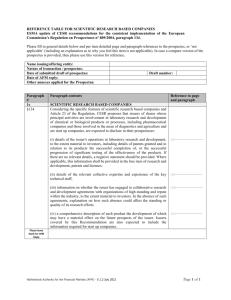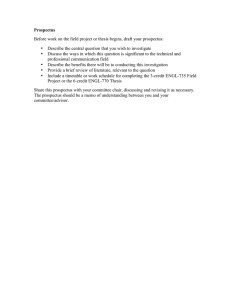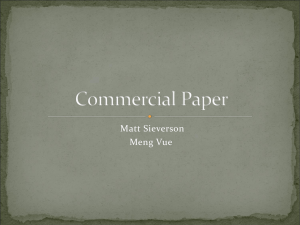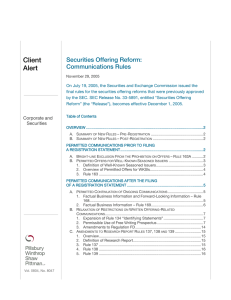Securities Regulation Prof. Palmiter - Spring 2006 SEC Public Offering Rules
advertisement
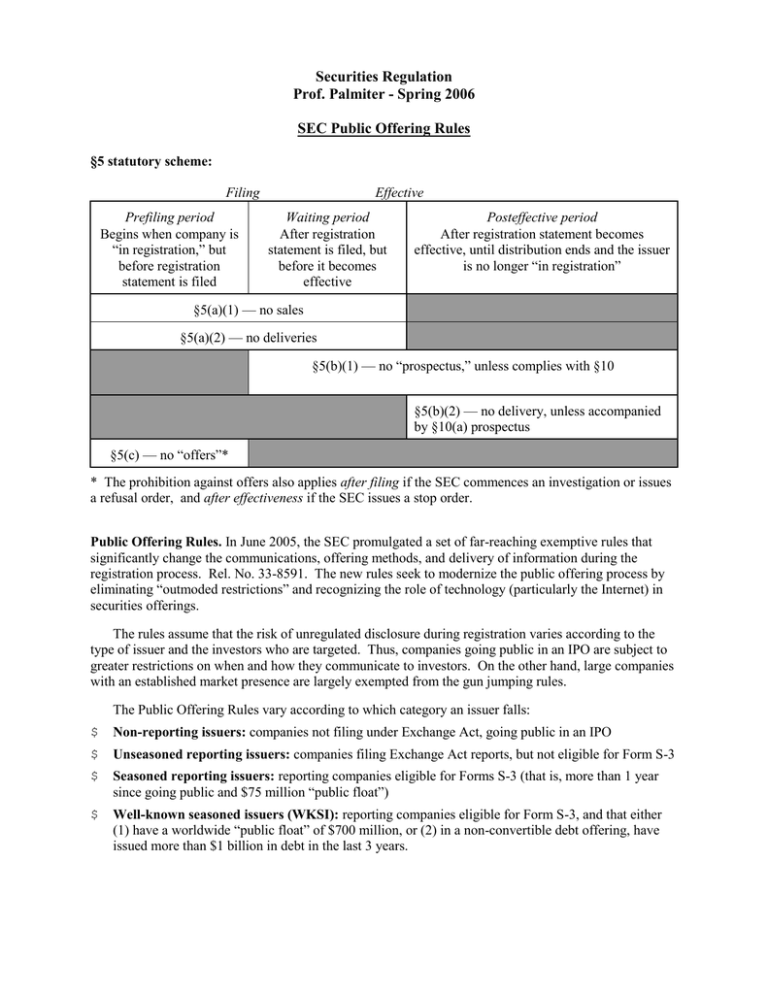
Securities Regulation Prof. Palmiter - Spring 2006 SEC Public Offering Rules §5 statutory scheme: Filing Prefiling period Begins when company is “in registration,” but before registration statement is filed Effective Waiting period After registration statement is filed, but before it becomes effective Posteffective period After registration statement becomes effective, until distribution ends and the issuer is no longer “in registration” §5(a)(1) — no sales §5(a)(2) — no deliveries §5(b)(1) — no “prospectus,” unless complies with §10 §5(b)(2) — no delivery, unless accompanied by §10(a) prospectus §5(c) — no “offers”* * The prohibition against offers also applies after filing if the SEC commences an investigation or issues a refusal order, and after effectiveness if the SEC issues a stop order. Public Offering Rules. In June 2005, the SEC promulgated a set of far-reaching exemptive rules that significantly change the communications, offering methods, and delivery of information during the registration process. Rel. No. 33-8591. The new rules seek to modernize the public offering process by eliminating “outmoded restrictions” and recognizing the role of technology (particularly the Internet) in securities offerings. The rules assume that the risk of unregulated disclosure during registration varies according to the type of issuer and the investors who are targeted. Thus, companies going public in an IPO are subject to greater restrictions on when and how they communicate to investors. On the other hand, large companies with an established market presence are largely exempted from the gun jumping rules. The Public Offering Rules vary according to which category an issuer falls: $ Non-reporting issuers: companies not filing under Exchange Act, going public in an IPO $ Unseasoned reporting issuers: companies filing Exchange Act reports, but not eligible for Form S-3 $ Seasoned reporting issuers: reporting companies eligible for Forms S-3 (that is, more than 1 year since going public and $75 million “public float”) $ Well-known seasoned issuers (WKSI): reporting companies eligible for Form S-3, and that either (1) have a worldwide “public float” of $700 million, or (2) in a non-convertible debt offering, have issued more than $1 billion in debt in the last 3 years. Exemptions (pre-filing period): Filing Prefiling period Effective Waiting period Posteffective period Release 3844 $ clarifies “offer” $ look at: motivation of communication, breadth of communication $ antipathy to FLI and naming of UW Rule 135** $ allows notice of public offering (exempts from definition of “offer”) $ applicable only to issuer $ limited information: issuer, security, amount offered, timing, manner and purpose (special requirements for rights offerings, offerings to employees, exchange offers, mergers) $ cannot name underwriter Rule 163* $ exempts WKSIs $ written communications treated as FWP, must be legended (read prospectus, where get copy) and filed with SEC when file RS $ not available to UW or other participant Rule 163A* $ creates safe harbor for issuers (but not UW) $ communications 30+ days before filing RS $ cannot reference offering Rule 168* $ exempts domestic reporting issuers (and seasoned reporting foreign issuers), but not UWs $ allows factual info and SEC-filed FLI, provided timing, manner and form similar to past releases $ may not reference offering Rule 169* $ exempts non-reporting issuers, but not UWs $ allows regularly released factual info, but not FLI $ given only to non-investors $ may not reference offering * Added by 2005 Public Offering Rules ** Amended by 2005 Public Offering Rules Exemptions (waiting period): Filing Effective Prefiling period Waiting period Posteffective period Rule 134** $ allows identifying information about issuer, exempts from definition of “prospectus” $ available to issuer, UW or participant $ (a) information: issuer info, info about security, issuer’s business, price of security, use of proceeds, identity of sender, names of UWs, schedule and nature of offering $ (b) during waiting period: must include legend and where obtain preliminary prospectus $ (c) can avoid (b), if use tombstone ad or accompany with preliminary prospectus $ (d) can seek investor interest, if accompany with preliminary prospectus and include statement that not binding, fully revocable Rule 135** [see pre-filing period] Rule 164* $ allows free writing prospectus (FWP), deemed to satisfy §10(b) if Rule 433 conditions satisfied $ available to issuer, UW or participant $ excuses immaterial or unintentional failure to file or legend FWP, if (1) good faith attempt, (2) filing or legend happens as soon as practicable after discovery, (3) properly-legended FWP re-sent $ ineligible issuers (Rule 405): not current with Exchange Act filings, “bad boys,” or subject to SEC investigation Rule 433* $ FWP can include info not in RS $ conditions: (1) info may not conflict with RS or SEC filings, (2) FWP must be legended (read prospectus, how obtain) $ must accompany FWP with prospectus $ seasoned issuers and WKSI: need not accompany with prospectus $ non-reporting and unseasoned issuers: if by issuer (or someone paid by issuer) must be accompanied by (or linked to) preliminary/final prospectus $ must file with SEC (on date of first use) $ issuers must file FWP and issuer info (press interview) $ participants must file FWP that is “broad unrestricted dissemination” $ record retention: must keep FWP for 3 years, if not filed Rule 168* [see pre-filing period] Rule 169* [see pre-filing period] Rule 405/433* - road shows $ oral communications permitted, and real-time webcast road shows treated as oral communication $ PPTs (deemed “graphic communications”): as FWP, are subject to consistency and legending conditions, must be accompanied by prospectus $ filing of PPT or other handouts $ generally not required $ equity offering by non-reporting issuers: must file PPT unless “bona fide electronic road show” (officers present, similar info as other road shows) is available online Rule 433* - press interviews $ FWP from issuer or participant (such as press interview) disseminated by media must be $ consistent with RS, other SEC filings, $ filed within 4 days issuer becomes aware $ if so and no payment made, media FWP not subject to prospectus-accompaniment rules, need not be legended $ filing can include corrections, or simply give transcript of what provided to media * Added by 2005 Public Offering Rules ** Amended by 2005 Public Offering Rules The Public Offering Rules also clarify what kinds of communications are covered: $ Electronic communications: New definitions clarify that electronic communications are a form of “graphic communications,” which are included in the definition of “written communications.” Rule 405. Thus, emails and website content are subject to the restrictions “prospectuses” during the waiting and post-effective periods. (Importantly, the SEC rules excludes “real time” communications from the “prospectus” definition – thus treating live online webcasts as oral offers.) $ Hyperlinks: The new SEC rules clarify that issuers are responsible for material that is hyperlinked on their websites. Rule 433(e). Thus, links to news stories or to websites that analyze stocks can be deemed an “offer” or “prospectus” – thus subject to restrictions absent an exemption. The issuer may, however, link to its own historic information.

